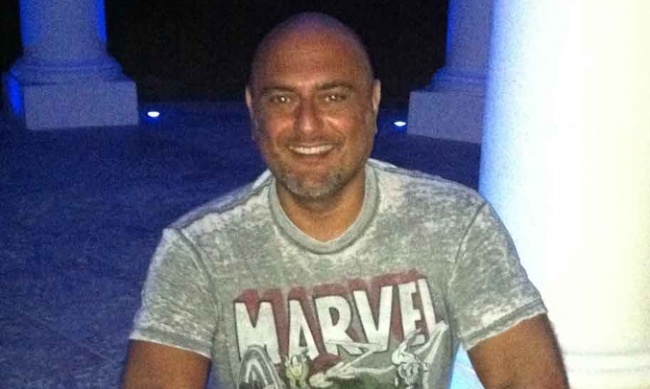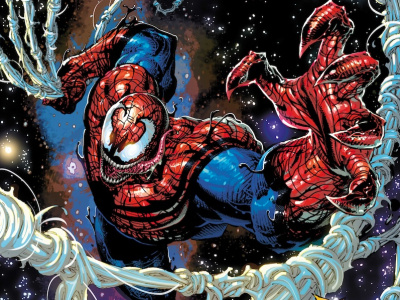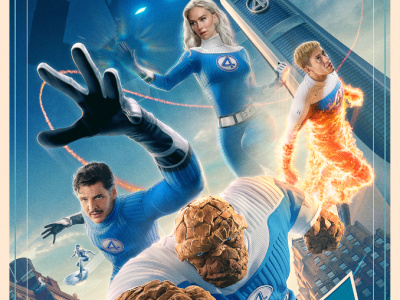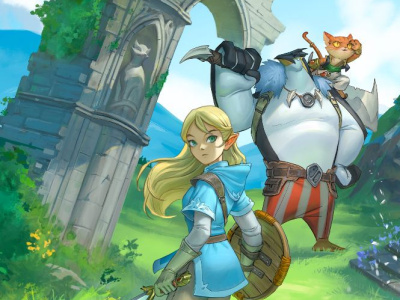We talked to Marvel Senior Vice President -- Print, Sales & Marketing, Marvel Publishing Worldwide David Gabriel at San Diego Comic-Con recently to get his view of the market and talk about some of Marvel’s latest moves. In Part 2 of our three-part interview, we talk about a new test in a large mass retailer, the digital market, changing the characters, and the kids market. In Part 3, we talked about the reasons to re-use Marvel Now!, comic price resistance, Champions, and big graphic novels for the coming seasons. And in Part 1, we talked about the overall state of the market, the graphic novel business, international sales, comic stores, and variants.
What are you doing with mass merchants right now?
We are in one mass retailer with a large graphic novel test program that started a couple of months ago.
In a subset of stores?
Yes. We’re about two-thirds of the products that are out there, and there are some DC titles, one or two Walking Dead and one other title in there. They continue to test the program and we’re in the process now of making sure we’re changing out titles so that the best books are what’s there so that we get a really good idea of what’s selling there.
Do media tie-ins do the best in an outlet like that?
I will say Deadpool, surprisingly, has done the best. And a $35 Deadpool book, not a $9.99 Deadpool. When we see stuff like that, you throw your hands up in the air and say you just can’t win. It’s an outlet known for $5 things. But they’re not ordering from the Diamond Previews monthly catalogue to put retailers out of business; they’re ordering backstock titles that are perennial sellers. I actually help hand-select the titles that are going in there on a regular basis so that we know what we’re testing.
Also coloring books for us have been beyond crazy.
We’re trying to ignore that but we can’t.
I’m glad I didn’t. I think it was a year ago that someone sent me, I think, a New York Times article. We used to do those Essentials that I hated, so we have the artwork, ‘we should just start doing coloring books.’ Everyone in the office sort of giggled about it, thinking ‘that’s not a thing,’ and eight months later, you see how many other comic publishers are doing it.
In that chart that Publishers Weekly put out, the category that coloring books is in, is up, I think 115%. A mass merchant will have a big coloring book program this Fall/Winter.
How about digital--what are you seeing there?
We’ve seen great growth in trades, which is from day one where I said the growth would be. It doesn’t make sense for single issues. Marvel Unlimited, the subscription service, does phenomenally well. The subscriber base has grown by leaps and bounds. I think we’re entering into the tenth year of that service.
Has there been any shift between download-to-own and all-you-can-eat service?
It’s hard to say because we had this switch with Amazon and comiXology in 2014 and then we also went strong with trades out to a lot of different areas because trades were a little slower to get out there. I think in a year or so we’ll know better what the shift is. But the subscription service works very well, I have to say.
You were there early. Now that format, in music, is now a thing. You were ahead of the market, but preferences seem to be shifting in that direction.
Yes. And just so people don’t get scared when they read this, we’re still six months behind the on-sale dates of the retailers, which hasn’t hurt at all. Even digital single sales, what we have seen is that they really match what is going on in the Direct Market. So it’s not much different. If you promote a book heavily, the digital sales really spike.
We want to shift and talk about the Marvel consumer. Over the last few years Marvel has worked very hard to create a line that has broader appeal demographically. From when we started in the business until very recently…
What year was that?
First comic show was in 1972.
Holy…, wow. Good for you.
And started in distribution in 1976. For that whole period, the teen and adult male consumer was the core audience. Now, obviously, you’re trying to reach a much broader demographic and you’ve been successful at that, so who do you see as the Marvel customer now? Who makes up the dollars and who are you publishing for?
Again it’s still kind of anecdotal. From things that we gather from some analysis that Disney does on who is buying Marvel as a brand, and from talking to retailers and looking at our titles, we’re probably up to at least 40% female, which eight years ago might have been 10%. And 15 years ago might have been nothing, while they were all buying manga. So there’s really been a shift, which is great, and it even could be even higher than 40%. I’m sure if you go into some retail shops in different parts of the country, that’ll be 50-60% female, and some lower. But that’s about what we’re seeing now. We also get some stats from digital; they’re a little better at knowing who the customer is.
Does the amount of change in the line risk alienating the base? You change all your characters all the time now to a much greater degree than 10 or 20 years ago. That may chase some people away and it may attract some new people. How do you manage those trade-offs?
The first thing we do is watch the sales. If you watch the Internet and the message boards, you would do the wrong thing. And I think there are publishers who do that, which is unfortunate. So that’s the easiest thing to do, is just watch the sales. When those shift, that’s when things shift. A good example is Superior Spider-Man a few years ago. Dan Slott presented that story as a six-issue story with Doc Ock Gets Spider-Man, the villain as the hero. And we all sat back and said if that is selling, it’ll be more than six issues. And we watched the sales, and he got 18 months out of it and it’s one of the most successful runs on Spider-Man of the past 15 years. We said the same thing with Mighty Thor. To me, the paradigm shift started for us when we brought in the female Thor, because that horrified and supposedly alienated the people you’re talking about, but it also certainly rejuvenated that character and that book and made it one of our bestselling books. It was up there, but certainly not one of our bestsellers. Now, three years later, she’s still around and we’re bringing the regular Thor back.
Obviously each one of these changes gets media attention which is good for the brand and the launch.
Yeah. Like with Iron Man recently. People are outraged. People are sending death threats to [Brian Michael] Bendis, which is sad. But at the same time we’re getting things from moms who say, "My daughter was in tears when she read this because now she has a superhero that she loves from the movies that she can actually aspire to." So we get the wide spectrum of everything and the results will be when the sales come out.
What do you think about the kids category and market? It seems to be a bigger part of the market now. How does Marvel try to reach that target?
Kids are still hard. When we talk Scholastic, I think of eight and up, but when I think about "kids" I think five- to eight-year-olds. We have Disney Publishing who does a lot with our movie and animated characters. And they do 8x8s and they have kids programs, and all of those books that are in the mass market and bookstores, and worldwide with the characters. We leave that up to them. We make sure that we have comic product to match up with the animation slate that we have. And then we put out other books that I think toe the line between what’s a kids book and what’s an adult book. Some of the Disney Kingdoms books have been right between kid and adult and they’ve brought in a lot of both. Ms. Marvel is certainly hitting the teen audience and the adult audience. Squirrel Girl is doing the same. That’s another book that Scholastic took in large amounts. And maybe it’s a lot of the female-centric titles that are getting to the kids. They read more…
So we’re always trying. It’s still a struggle. We’re trying to put out good quality stuff that they can enjoy and it’s just hard to reach them.
We put out a treasury edition of Spidey stories. It’d be great to hear that kids got that and loved it, but I bet it’s people my age that love that format again.
Click here for Part 3.

Mass Test, Digital, Changing the Characters, and Kids
Posted by Milton Griepp on August 16, 2016 @ 4:39 am CT
MORE COMICS
'Venom' #252 to Feature Backup Story with New Suit, Plus New Story by DeFalco and Frenz
August 4, 2025
Venom #252 will feature a backup story about Venom’s new suit as well as a backup story by Tom DeFalco and Ron Frenz, the creators of the symbiote suit.
Showbiz Round-Up
August 4, 2025
The post-SDCC showbiz news is still spicy a week after the show's conclusion. It's time for another round-up!
MORE NEWS
New Anime-Style RPG by Two Little Mice
August 4, 2025
Free League Publishing announced Twilight Sword RPG , a new RPG by Two Little Mice.
'Tessen: The Battle for Toshi Ranbo'
August 4, 2025
Office Dog previewed Tessen: The Battle for Toshi Ranbo , an Legend of the Five Rings board game.








